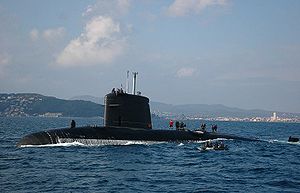Rubis-class submarine

Casabianca in April 2005
|
|
| Class overview | |
|---|---|
| Name: | Rubis class |
| Builders: | DCNS |
| Operators: |
|
| Preceded by: | Daphné class |
| Succeeded by: | Barracuda class |
| In commission: | 23 February 1983 |
| Planned: | 8 |
| Completed: | 6 |
| Cancelled: | 2 |
| Active: | |
| General characteristics | |
| Type: | Nuclear attack submarine |
| Displacement: |
|
| Length: | 73.6 m (241 ft) |
| Beam: | 7.6 m (25 ft) |
| Draught: | 6.4 m (21 ft) |
| Propulsion: |
|
| Speed: | over 25 kn (46 km/h; 29 mph) |
| Range: | Unlimited distance; 20–25 years |
| Complement: |
|
| Sensors and processing systems: |
|
| Armament: |
|
The Rubis type is a class of first-generation nuclear attack submarines of the French Navy. The class comprises six vessels and they are the most compact nuclear attack submarines to date. All submarines of the class (except for Casabianca) are named after gemstones.
Although the Rubis class belonged to the same generation as the Redoutable, due to President Charles De Gaulle's insistence on acquiring a nuclear deterrent for France, the Rubis program was started only in 1974, after the ballistic missile submarine program. The first Rubis hull was laid down in December 1976 and launched in 1979.
In 1987, the Canadian White Paper on Defence recommended the purchase of 10 to 12 Rubis or Trafalgar-class submarines under technology transfer, which would be known as the Canada-class. with the choice of the type of submarine due to be confirmed before Summer 1988. The goal was to build up a three-ocean navy and to assert Canadian sovereignty over Arctic waters.
The Rubis-class as designed failed to meet the Canadian Statement of Requirement (SOR) as it was noisy underwater and slow. It also came with the caveat that the first 4-5 submarines would have to be built in France. Unlike the British Trafalgar-class, the Rubis design did not require USA permission to transfer the nuclear propulsion technology, as the Americans were certain to invoke their veto of the sale to Canada. The French brought back a revision to their design, added an "ice pick" so the submarine could operate under ice and were developing a modification for their torpedo tubes which were too short to use the Mark 48 torpedoes. The purchase was finally abandoned in April 1989 due to high costs, particularly with the end of the Cold War.
The initial design of the Rubis proved to be problematic with unexpectedly high noise levels. This led to the Améthyste silencing program (AMÉlioration Tactique HYdrodynamique Silence Transmission Ecoute, literally Silent Acoustic Transmission Tactical Hydrodynamic Amelioration) which was applied to the fifth (S605 Améthyste) and sixth (S606 Perle) hulls.
...
Wikipedia
